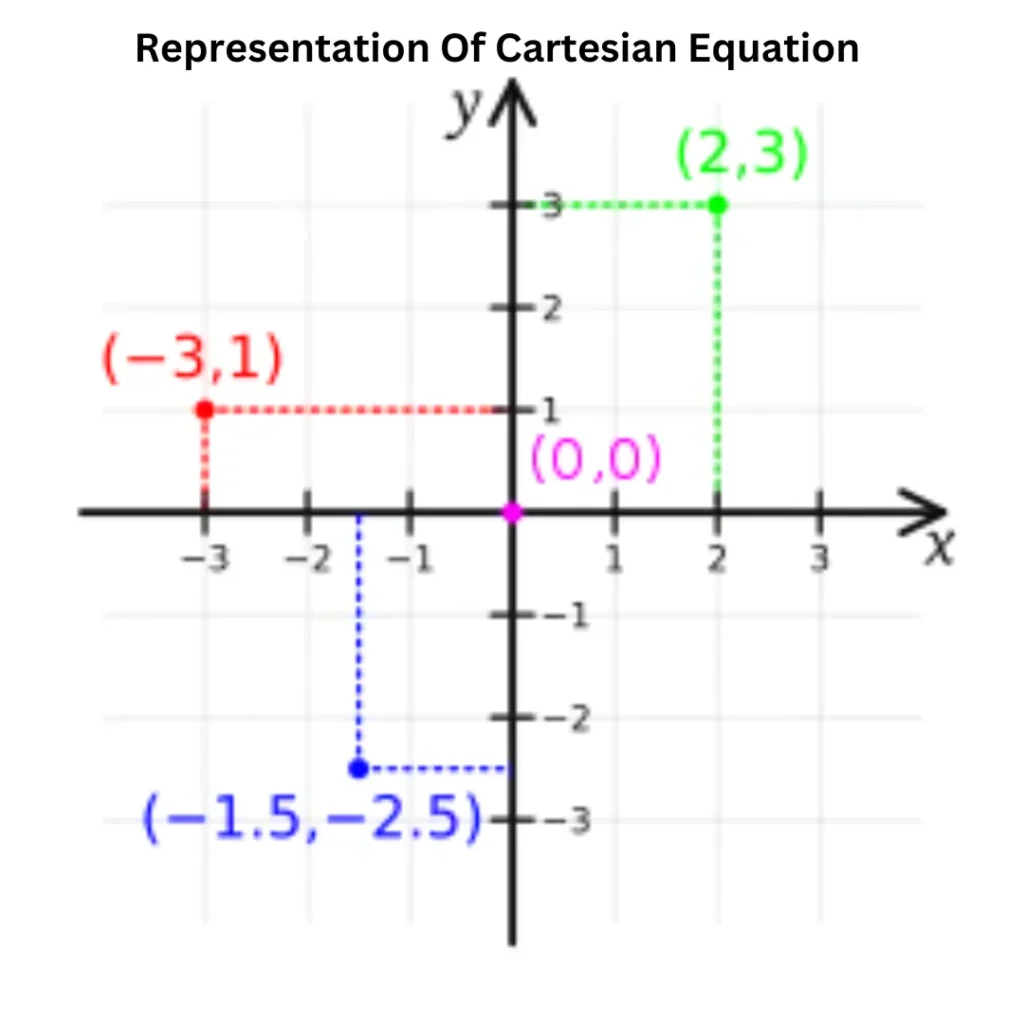In mathematics, a Cartesian equation plays a vital role. It refers to an equation that defines a relationship between variables in terms of their coordinates on a Cartesian plane. The Cartesian plane is a two-dimensional coordinate system that uses a horizontal x-axis and a vertical y-axis to locate points in space.
Moreover, a point is represented by an ordered pair of numbers (x, y) in the Cartesian coordinate system, where x represents the distance from the y-axis, and y represents the distance from the x-axis. The origin of the coordinate system is located at (0, 0), where the x and y axes intersect.
A Cartesian equation typically forms a polynomial or a set of polynomials in the x and y. The solutions to the equation correspond to the points on the Cartesian plane that satisfy the equation. For example, the equation y = x^2 represents a parabola that opens upwards, and its solutions correspond to the points on the Cartesian plane that lies on the curve.
In this blog, we are going to share with you everything about the Cartesian Equation. Let’s get started.
History of Cartesian Equations
Table of Contents
French philosopher and Mathematician Rene Descartes have originated the word Cartesian, and it was published in 1637. Pierre de Fermat has autonomously found it, who used to work in 3 scopes, though Fermat has not found its discovery. Fermic cleric Nicole Oresme has used structures parallel to Cartesian cooperates, which was very good before the time of Fermat as well as Descartes.
There is a growth of the Cartesian system, which plays an essential position in the progress of calculus provided by Gottfried Wilhelm Leibniz & also Isaac Newton. There is a two-coordinate explanation of the plane, which has been then evaluated in the theory of vector spaces.
What Is Cartesian Equation?
There is a curve in the Cartesian equation, which is generally evaluating a particular equation of a curve in the standard, and there are xs and ys are only two variables. You need to explain the parametric equations to find the equation instantaneously: If there is y = 4t, then both of the sides by 4 to find (1/4) y = t. An equation of a curve or surface in which the variables are the Cartesian organizes of a point on the curve or surface.

Why Is The Cartesian Equation Used?
Cartesian equations are used in various mathematical fields, including algebra, geometry, calculus, and physics. They provide a powerful tool for describing and analyzing mathematical relationships between variables and are an essential concept in modern mathematics.
Example Of Cartesian Equation
These are the following examples of the Cartesian Equation.
Example 1:- The curve is related to parametric equations:-
- x = 2 + t2 y = 4t
- Let us evaluate the Cartesian equation of the curve.
To evaluate the equation, the parametric equations should be solved instantaneously.
If y = 4t, separate both sides with 4 to find (1/4) y = t.
The new value of t is changed with the equation for x
- x = 2 + (1/4(y)) 2 – expand the bracket (square both 1/4 and y) to derive x = 2 + 1/16 y2.
Theoretically, the last equation is in Cartesian form because it contains variables x & y, though in an additional reorganized equation to choose standard ‘y =’ form:
- x = 2 + 1/16 y2 (minus 2 from both sides)
- x – 2 = 1/16 y2 (multiply each side by 16)
- 16x – 32 = y2 (& finally take square roots of both sides)
- y = SQRT (16x-32)
Example 2:- The equation of a circle with a center at (2,3) and a radius of 4 can be written as:
(x – 2)^2 + (y – 3)^2 = 16
In this equation, x and y represent the coordinates of any point on the circle. The term (x – 2)^2 represents the distance squared between the x-coordinate of a point on the circle and the x-coordinate of the circle’s center.
(2), and (y – 3)^2 represents the distance squared between the y-coordinate of a point on the circle and the y-coordinate of the center of the circle
(3). Adding these two distances and setting the sum equal to the radius squared (16) gives us all the points on the circle.
Dimensions of cartesian equation
There are many dimensions in the Cartesian Equation, which are as under:
One Dimension
Selecting a Cartesian coordinate system for a one-dimensional space which is for a straight line, and it includes selecting a point O of the line from the origin, a unit of length, and also an orientation for the line. An orientation selects that which of the two lines are decided by O is positive as well as which is negative. A line that is chosen Cartesian system is known as the number line. There are some real numbers, and all real numbers are having a particular location on the line. Every point in the line can be understood as a number in a well-organized range like the real numbers.
Two Dimension
A Cartesian coordinate system in two dimensions is stated by an organized pair of the perpendicular axis. A single unit of length for both pairs, & also an alignment for each axis. The point where the axes meet is known as the origin for both so turning each axis into a number line.
Three Dimension
The cartesian coordinate system for a three-dimensional space comprises of an organized triplet of axes. Which go with a common point, & also pair-wise perpendicular; an orientation for each ax; & a single unit of length for all three axes. The Cartesian relates of P are those three numbers, in the chosen order. The opposite construction regulates the point P is three coordinates.

Representation Of Cartesian Equation
Below, you can present the Cartesian Equation with this example.

Cartesian Equation Formula
The Cartesian equation formula represents the relationship between variables x, y, and z in three-dimensional space. It is given as follows:
Ax + By + Cz + D = 0
where A, B, C, and D are constants.
In two-dimensional space, the Cartesian equation formula for a straight line is given:
y = mx + c
where m is the gradient of the line, and c is the y-intercept.
Application of the Cartesian Equation
Cartesian coordinates are a concept that has an assembly of usual features in the real world. Although there are three constructive phases which are involved in covering coordinates on a problem application:
- An origin should be allocated to a particular spatial location or landmark.
- Units of distance should be decided to explain the spatial size signified by the numbers used as coordinates.
- The orientation of the pairs should be explained using available directional cues for all but one pair.
Quick Links
- A Brief Knowledge Of Kinematics Physics Equations
- What Is Conservation Of Energy Equation And How Does It Work?
Conclusion
The Cartesian equation is a way to represent geometric objects such as lines, circles, and curves using algebraic expressions. It involves defining a coordinate system with two perpendicular axes (x and y), and representing points in the plane as ordered pairs of numbers (x, y).
In general, a Cartesian equation takes the form of an algebraic equation involving x and y, such as y = mx + b for a line, or x^2 + y^2 = r^2 for a circle. These equations can be used to graph the corresponding geometric object by plotting points that satisfy the equation.
Now you have seen the best-ever guide on Cartesian Equations. Get the best assignment help from the experts at nominal charges. We are offering the world-class services to the students at nominal charges.
Frequently Asked Questions
What Is Cartesian Rule?
1) Light initially propagates from left to right. 2) The Cartesian coordinate system’s origin is at the optical component’s center.
What Is Cartesian Logic?
Cartesians adopted an ontological dualism of two finite substances, mind (spirit or soul) and matter. The essence of the mind is self-conscious thinking; the essence of the matter is an extension of three dimensions.
How Do You Convert To Cartesian Equation?
Summary: to convert from Polar Coordinates (r,θ) to Cartesian Coordinates (x,y): (i)x = r × cos( θ ), (ii) y = r × sin( θ ).



